I've enjoyed working with more types of fish than just angelfish since I was a small child. I've always had fancy livebearers of some type, usually guppies, but often other ornamental types. There was a period about 25 years ago that I had some amazing swordtails. They were huge, vigorous and prolific fish. I hadn't seen anything like them in years. I was keeping my eye open for something similar, but never ran across any. Finally, I decided to try to create my own. I usually go back to wild when I want fish that look and act like they're supposed to. My search for good wild stock led me to Select Aquatics, where I purchased a few strains from Greg Sage a couple of years ago. I picked up some Xiphophorus alvarezi in albino form and some X. nezahualcoyotl. It was the "nezzies" that really caught my eye - very thick bodies, deep caudal peduncles, wide dorsals and a bold attitude.
No matter where I get my fish, they all go through an extremely intensive quarantine and treatment period. In fact, the original stock never leaves quarantine. All in all, it takes me about 6 months to a year just to get newborn fry that I can move into a breeding room. The albino alvarezi didn't do too well in quarantine. I put the last male in with some red Hi-fins before I ended up losing all of the alvarezi. Fortunately, two generations later I did get a couple of albino offspring, so I know those fry contained some of alvarezi genetics. The nezzies did well and since my main purpose is the wild-cross, I mixed them with the Red Hi-Fin stock also.
I now had a mix resulting from two wild swordtails and one domestic line of Red Hi-fin swords. The F3 offspring from this mix have come into a breeding room. After raising them for 4-5 months, I've got quite the assortment of color, body shapes, sword lengths and fin type. The growth rate has been amazing on these hybrids - just what I was hoping for. Now, I have to decide what direction to take them. The Hi-fin trait is not a wide branching fin at this point. It will need a lot of work for those that I decide to set up to carry that trait. Color-wise, I really like the wild-type ones that have a patch of red on their upper backs. Many of these also have green swords, instead of the orange sword from the Red stock. This is the fun part. The part where I now get to take the line into different directions. At this point, the genetics is very diverse. It will take a few generations to double up on genes (increase homozygosity) to "fix" the traits I'm after.
The photos below will show how diverse the group is. It's actually missing the best Red Hi-fin offspring, since I already moved them to their own tank which is not in the best position to photograph at this time. You can purchase them from our Fish Store here:
I like the wide caudal peduncle on the young Hi-fin male at the right

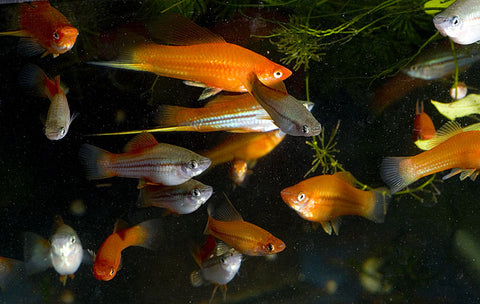
Notice the wild-type fish on the left, If it didn't have the hi-fin trait, it could almost pass for a young nezzy.

Color patterns like those in the center of this photo are very attractive to me. Wild-type with a blaze of color across the back is very eye-catching.
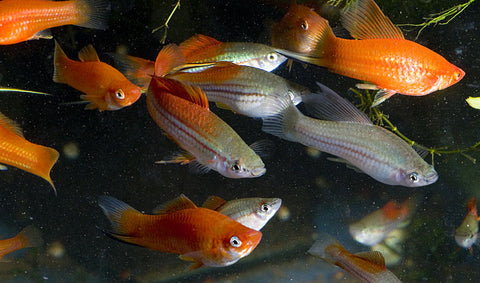
Another male with a nice thick body.



The male in the center here has a better hi-fin than the rest. He also has the color pattern I like and the green sword. I think he will make the final cut quite easily.
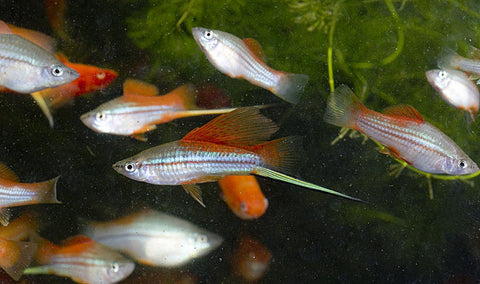
This one will like also be a breeder. His body shape is what I'm looking for.
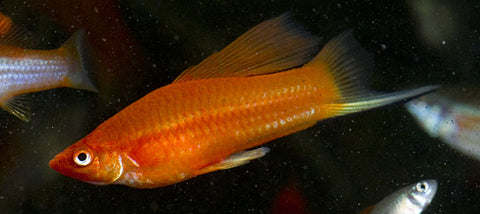
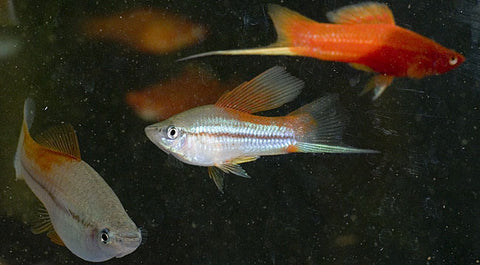
Please comment below and give us your thoughts on this project.
